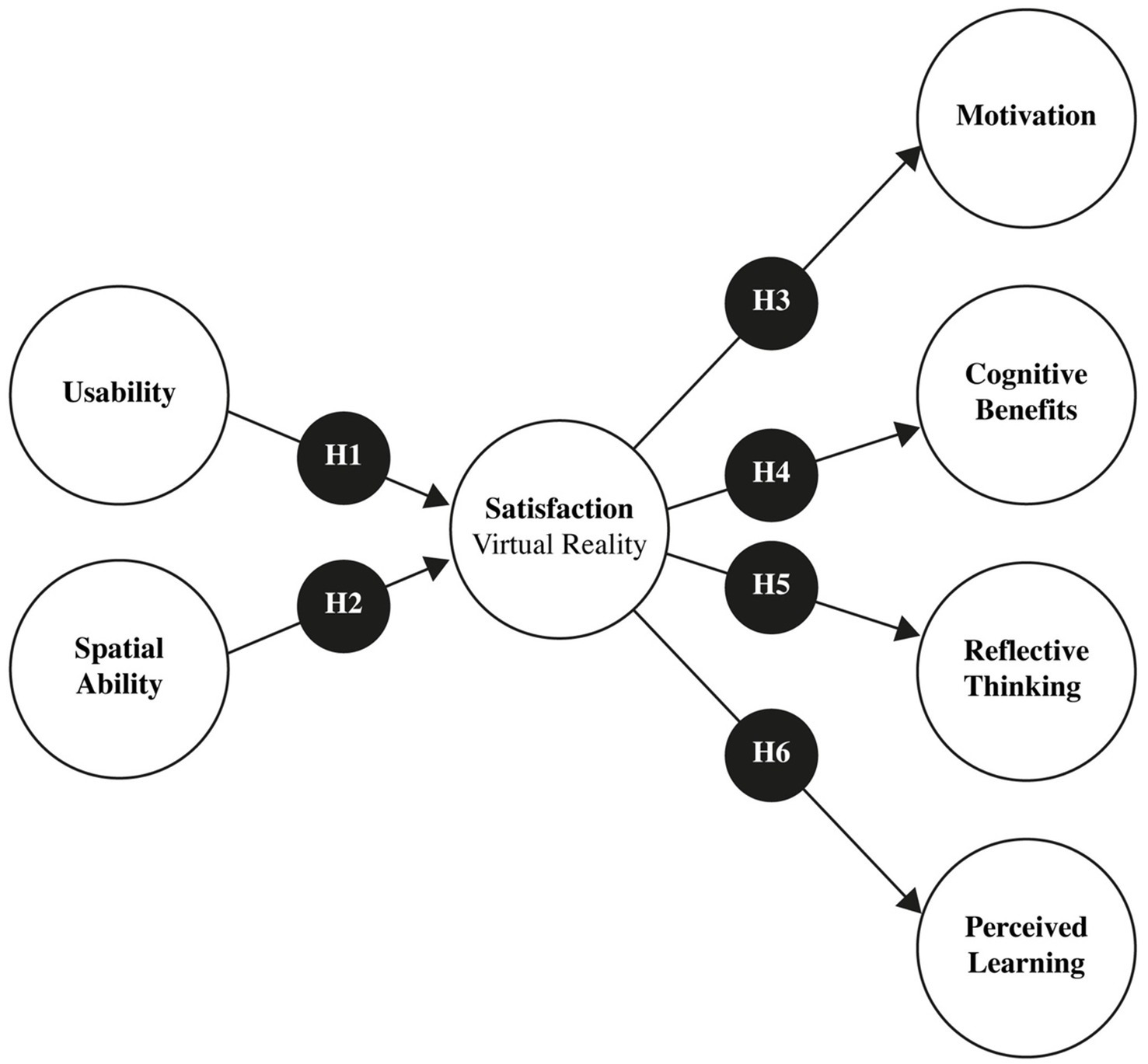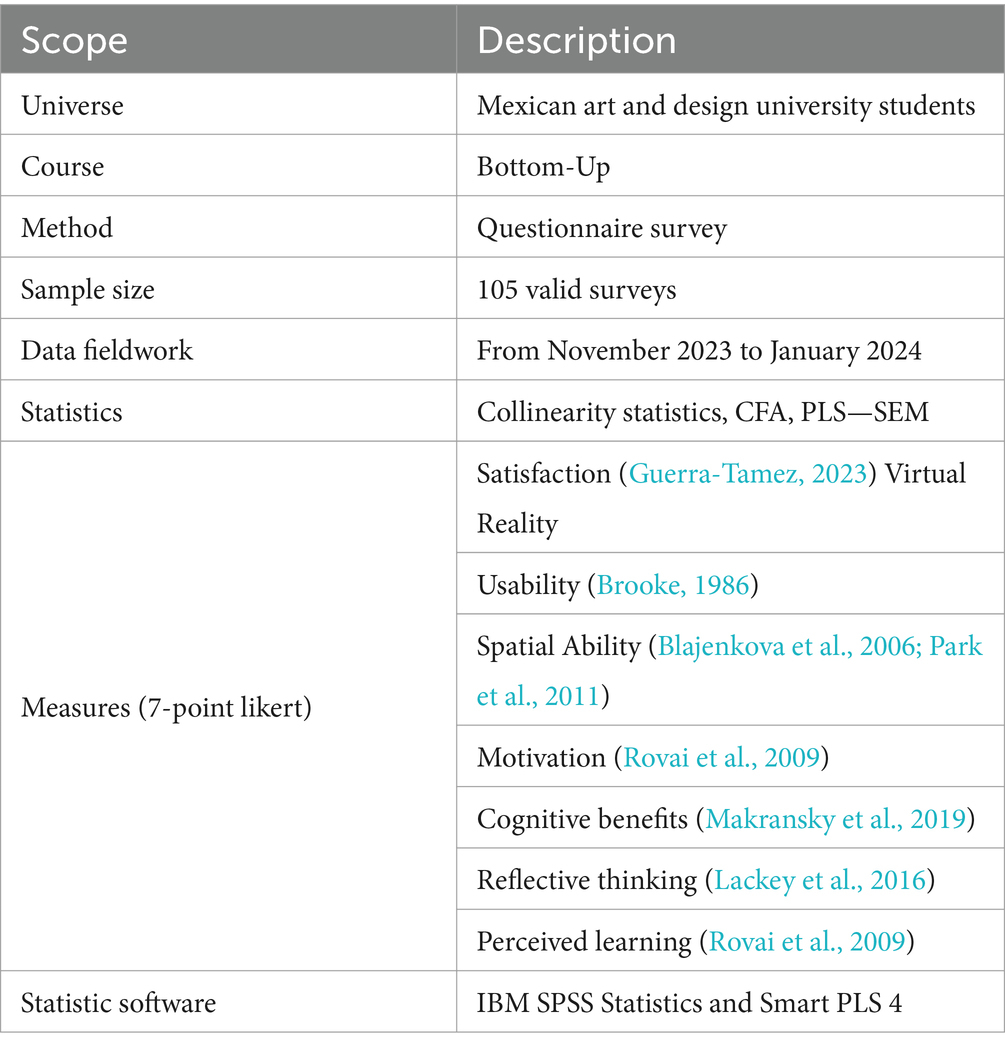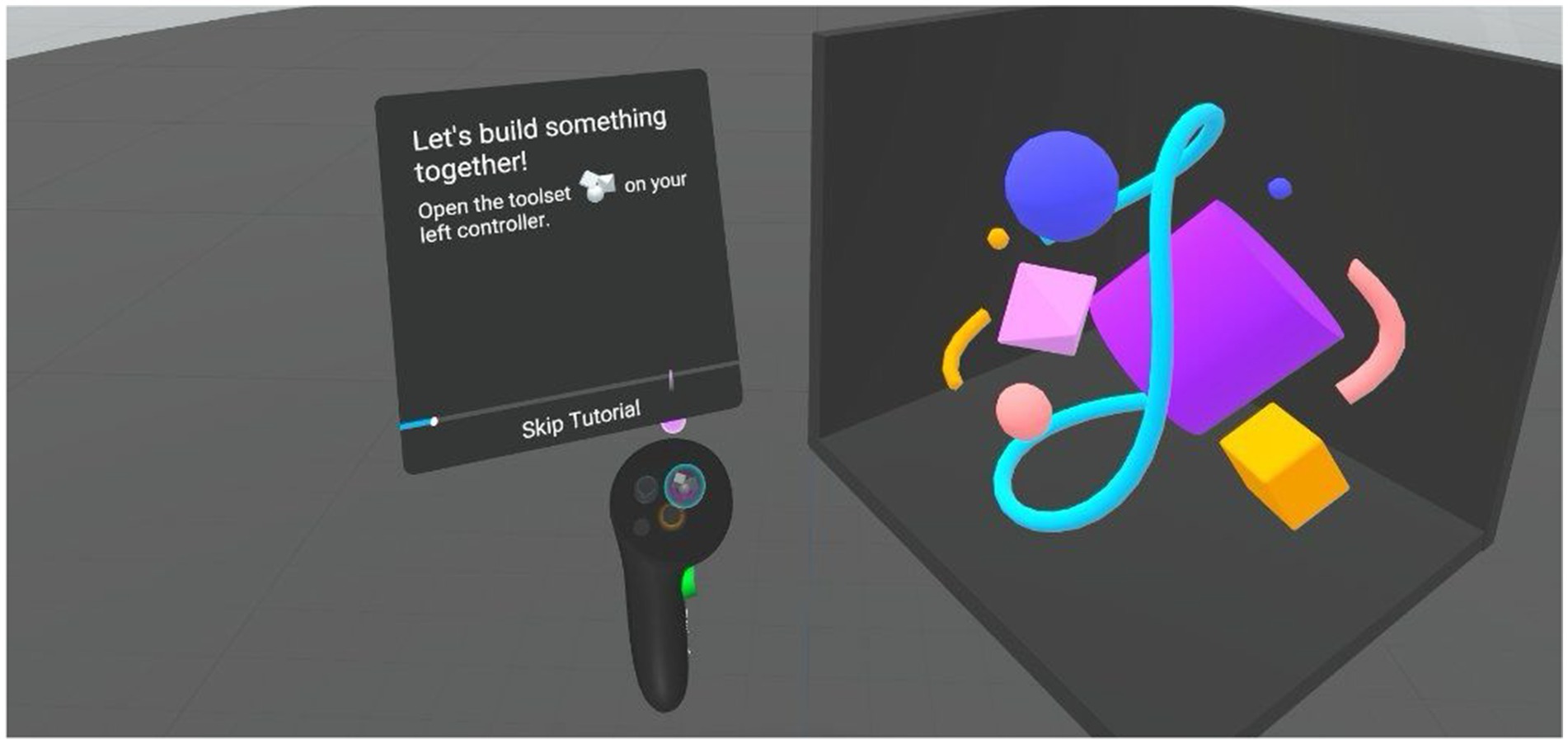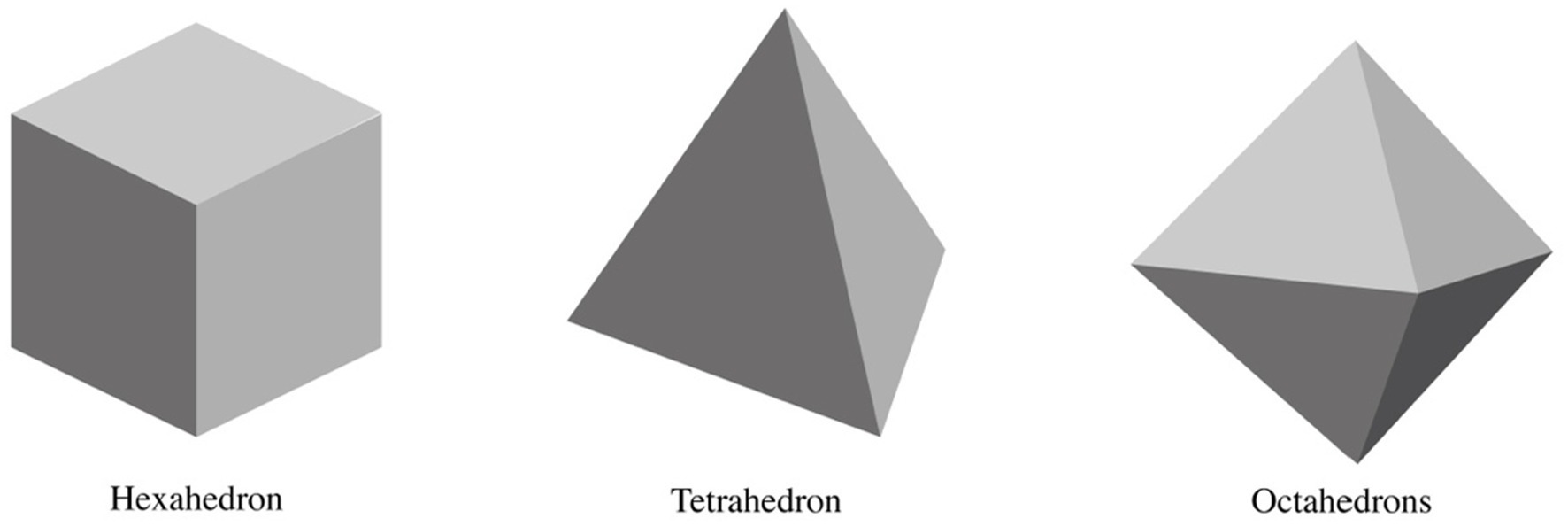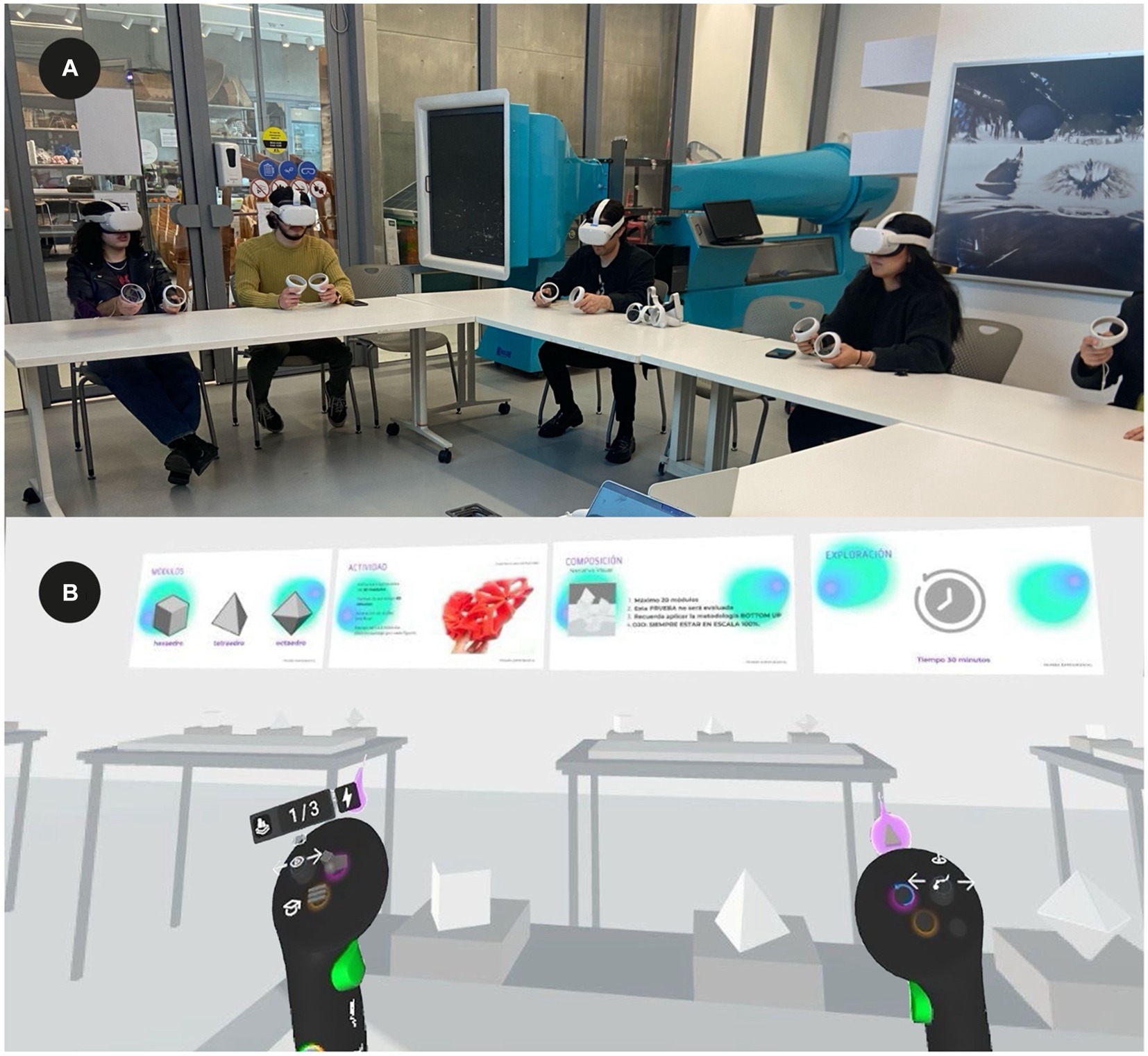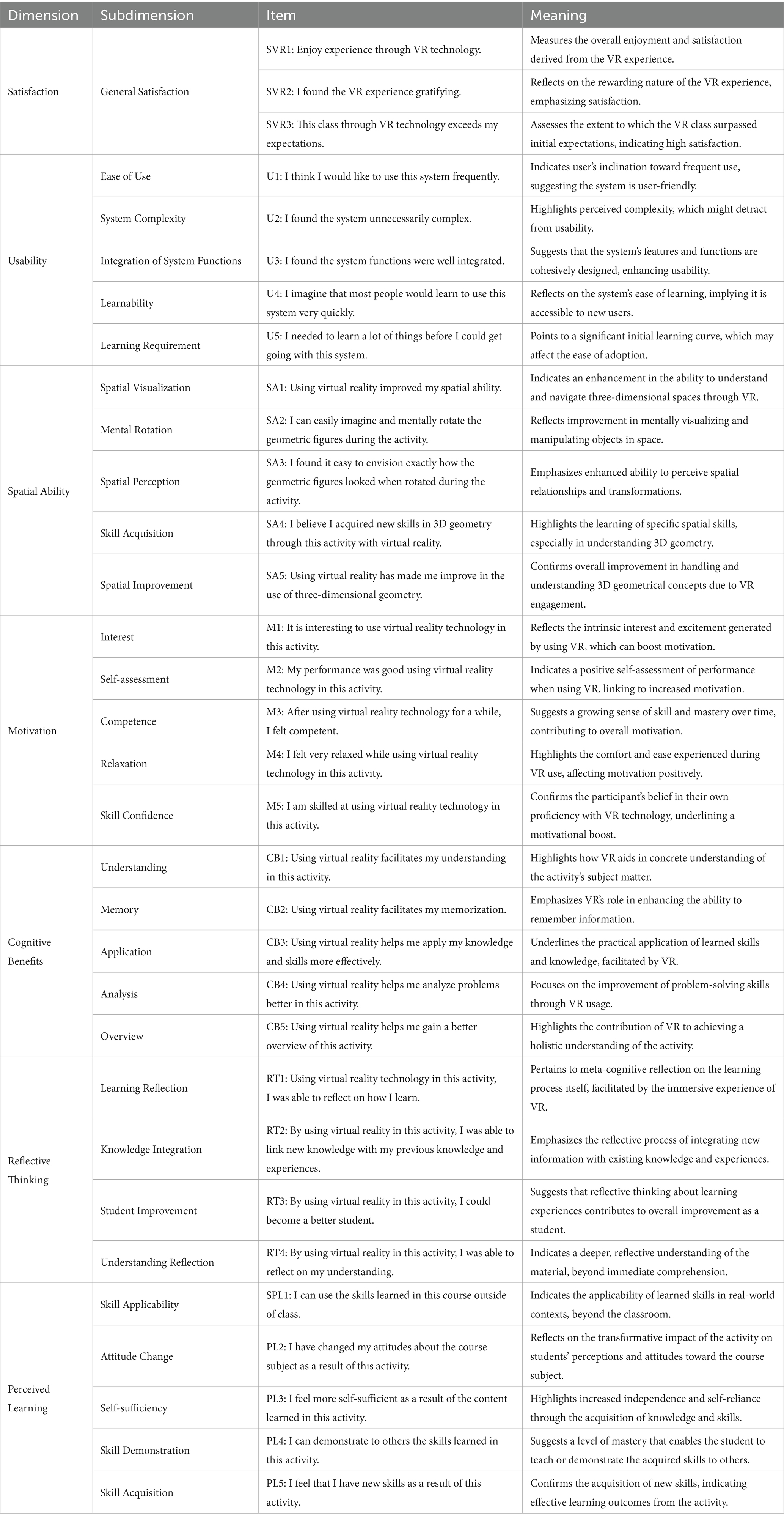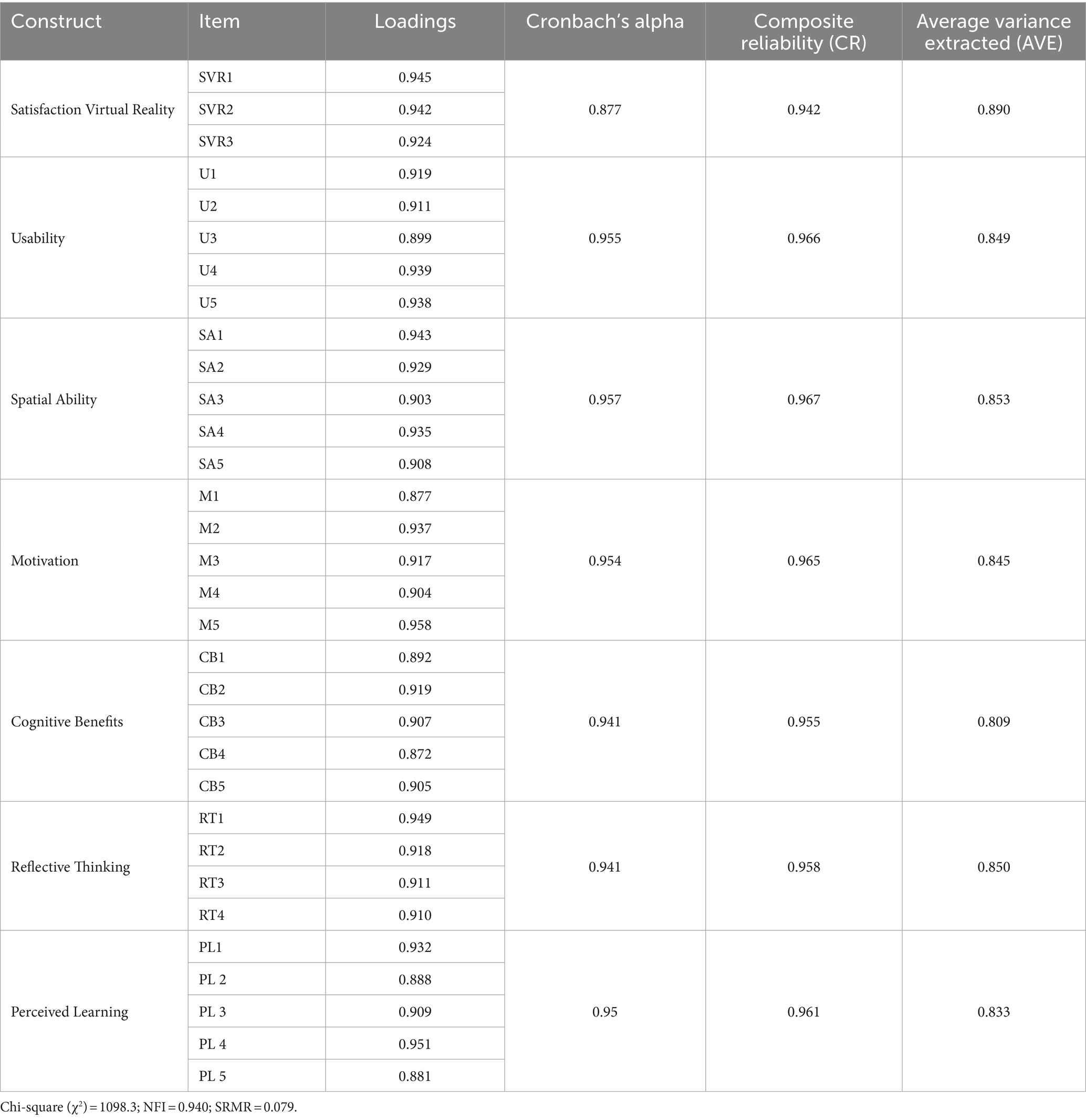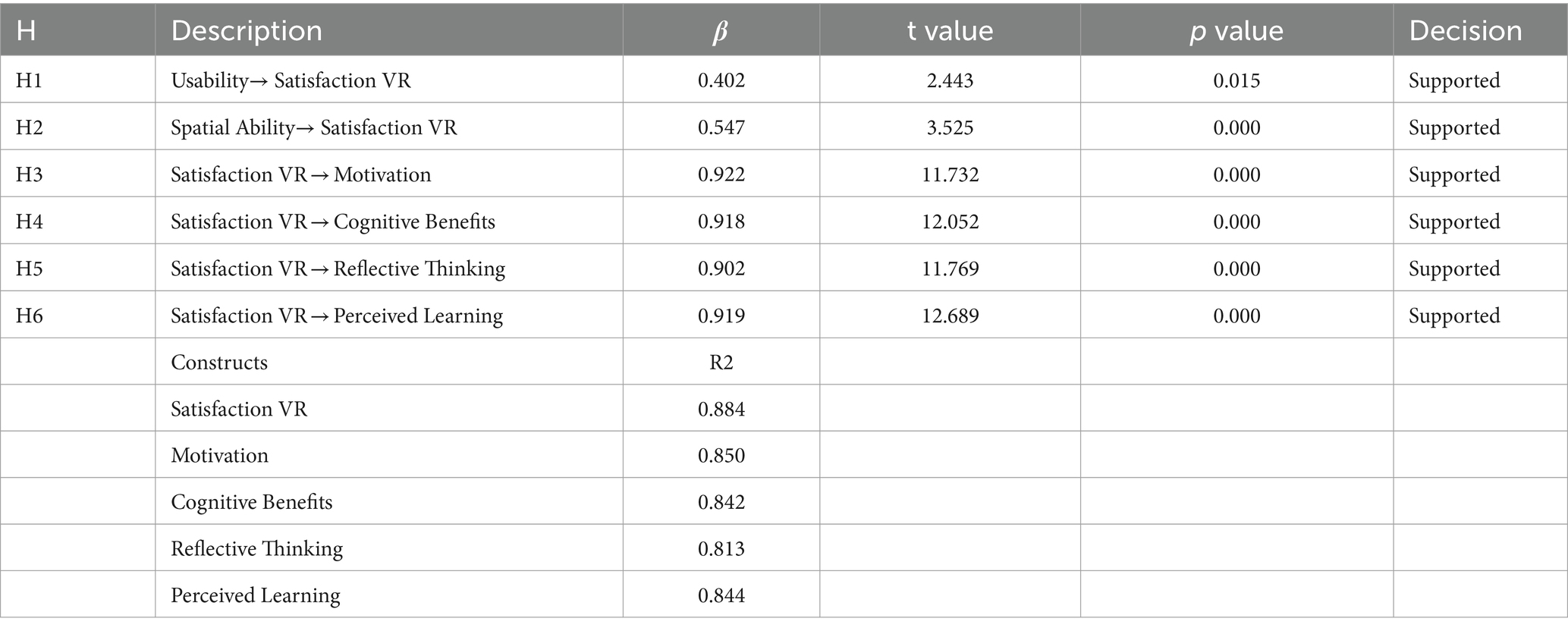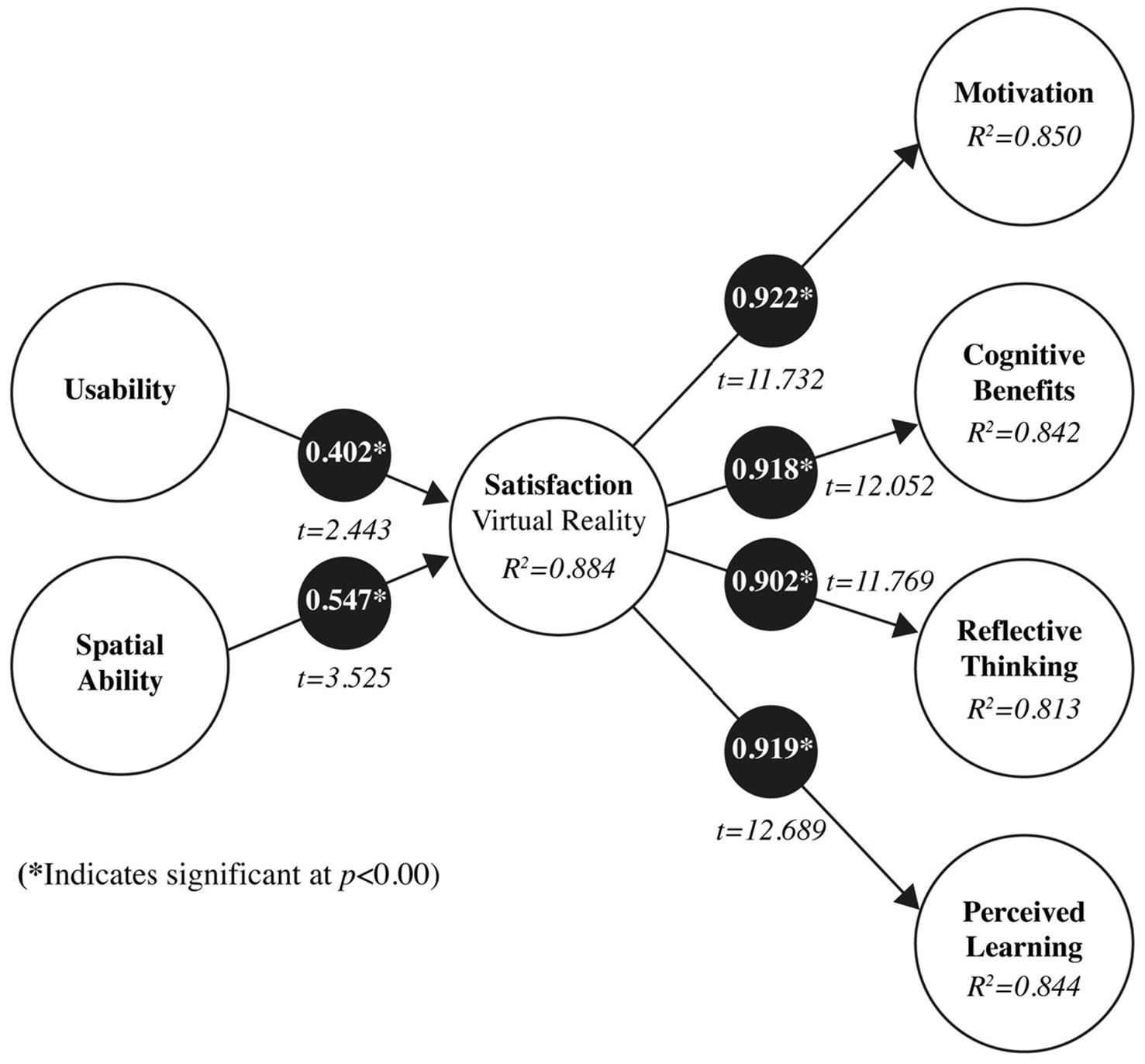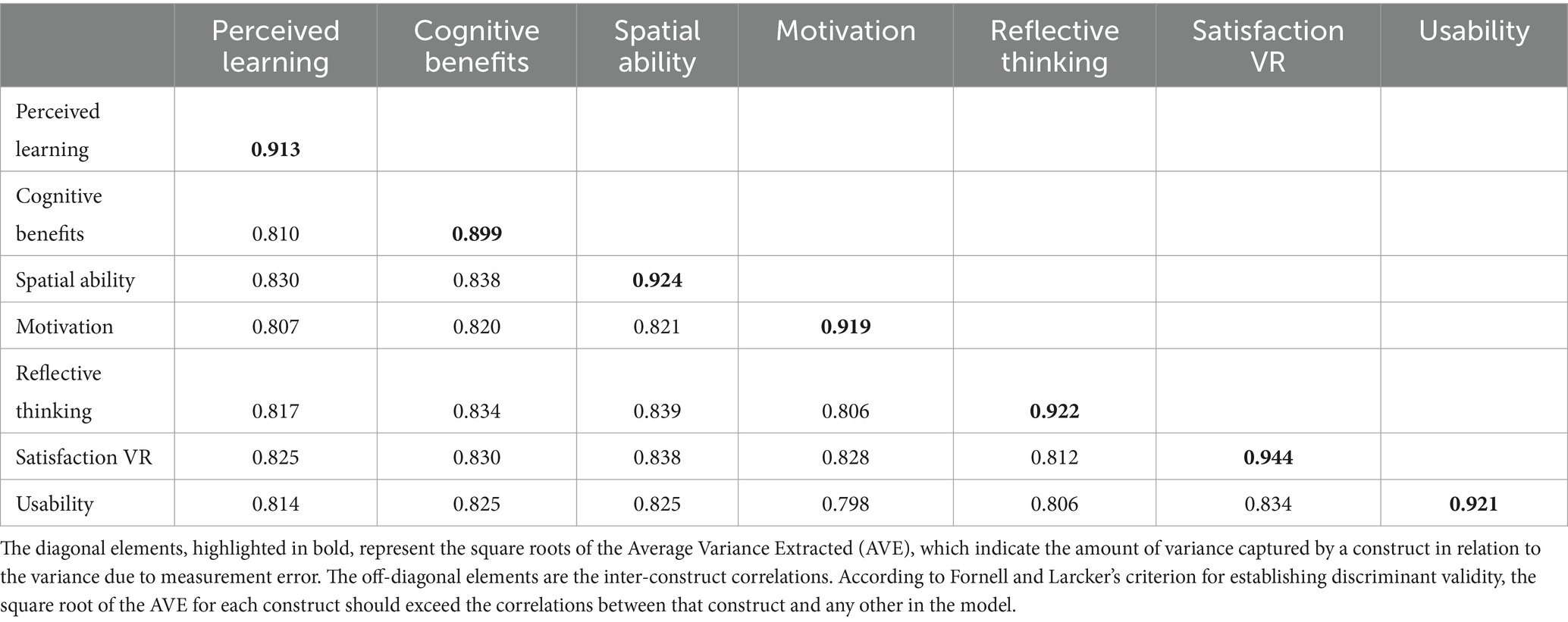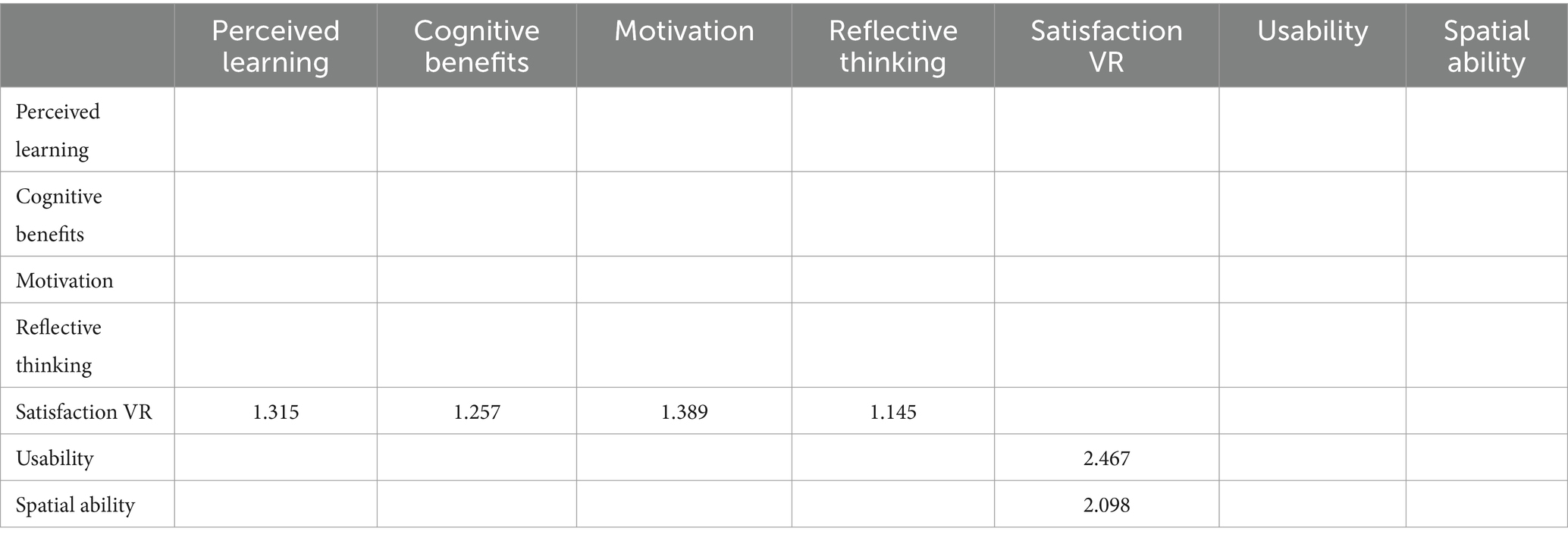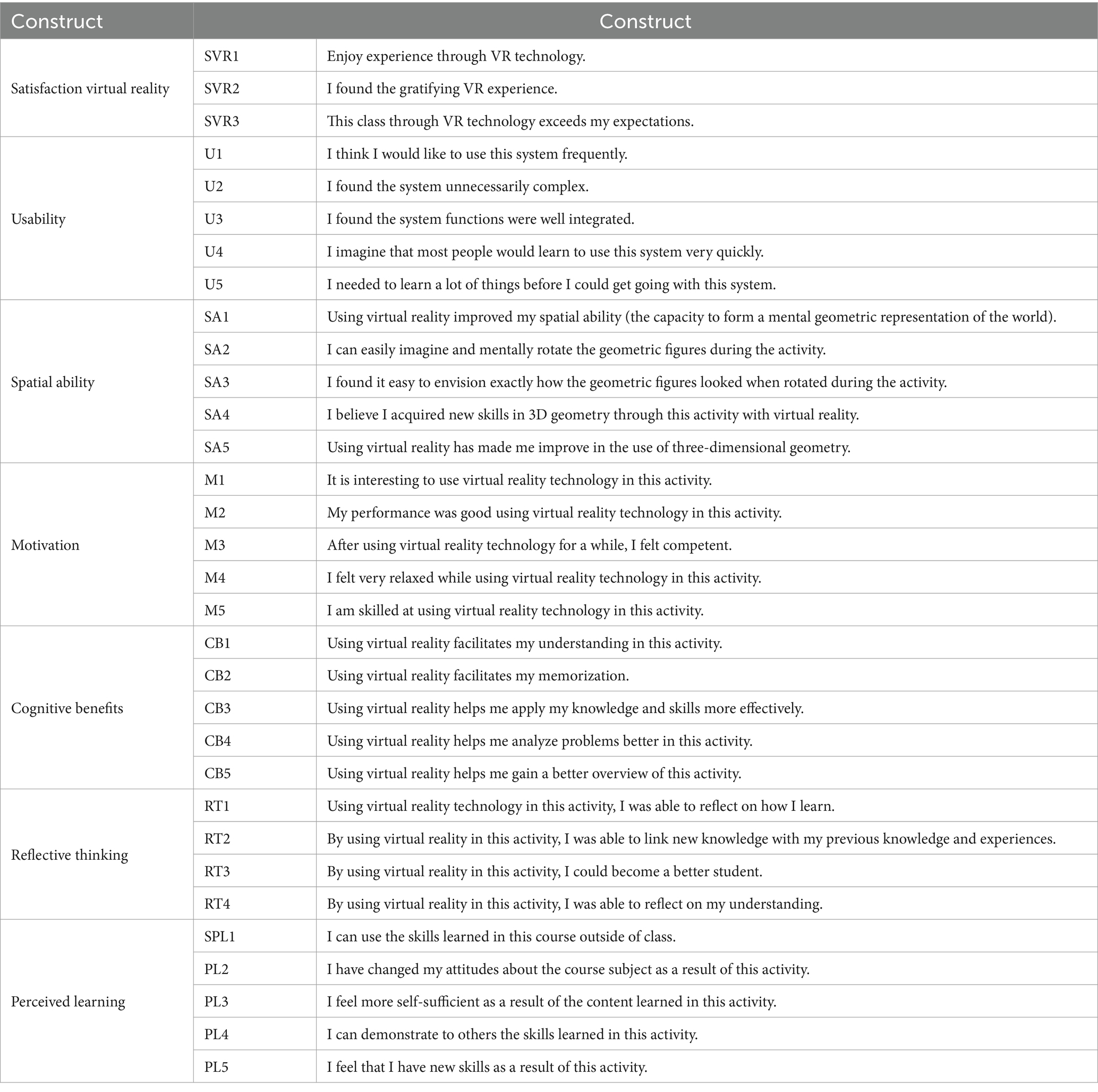Shaping the future of creative education: the transformative power of VR in art and design learning
- Art and Design Department, Centro Roberto Garza Sada de Arte, Arquitectura y Diseño, Universidad de Monterrey, Nuevo León, Mexico
Addressing a critical gap in the understanding of virtual reality (VR) in education, this study develops and validates a predictive model to elucidate the influence of usability and spatial ability on learning satisfaction among art and design undergraduates. Utilizing structural equation modeling on data from 105 art and design students in Mexico, we demonstrate that enhanced usability and spatial ability in VR significantly predicts increased learning satisfaction, which in turn, positively affects motivation, cognitive benefits, reflective thinking, and perceived learning. Our findings reveal a direct correlation between VR environment design and educational outcomes, suggesting that meticulous attention to usability and spatial navigation can substantially elevate the learning experience in art and design students. This research contributes to educational technology by offering empirical evidence on optimizing VR for higher education, with implications for curriculum design and pedagogical strategies in creative disciplines.
1 Introduction
The advent of virtual reality (VR) technology has revolutionized educational methodologies over the past few decades, offering novel tools that significantly enrich learning experiences (Marougkas et al., 2023). Notably, VR stands out for its ability to immerse students in interactive and stimulating environments, thereby fostering deeper and more meaningful learning processes. This technology is particularly beneficial in art and design education, where sensory experience and spatial perception are crucial to the learning journey (Kerr and Lawson, 2020; Guerra-Tamez, 2023).
Drawing from a constructivist theory, which posits learning as an active process wherein students construct new ideas or concepts based on their current knowledge and experiences (Pande and Bharathi, 2020), VR environments serve as an ideal platform for implementing these principles (Soliman et al., 2021). The immersive and interactive nature of VR allows art and design students not only to observe but also to actively engage in their educational process, thus facilitating more effective and personalized knowledge construction (Guerra-Tamez, 2023).
This study aims to develop and validate a predictive model using structural equations to explore how usability and spatial ability in VR environments influence undergraduate art and design students’ satisfaction. Student satisfaction, viewed as an indicator of the quality and effectiveness of the educational experience, is hypothesized to be a key predictor of learning success. Furthermore, the study examines how this satisfaction impacts essential aspects of learning, including motivation, cognitive benefits, reflective thinking, and perceived learning.
Investigating these relationships is crucial for understanding how emerging technologies like VR can be optimized to enhance education. As VR becomes a more accessible and prevalent educational tool, identifying and addressing factors that influence the quality of students’ learning experiences is paramount. This research contributes to the existing literature by providing a detailed analysis of how usability and spatial ability in VR affect satisfaction and, consequently, learning outcomes in specific educational contexts.
2 Literature review
2.1 Virtual reality in education
VR has emerged as a transformative catalyst in education, offering interactive virtual environments that support immersion and active engagement (Won et al., 2023). Studies have shown that VR facilitates deeper understanding and knowledge retention by promoting hands-on learning experiences, which are crucial in disciplines where direct experience and object manipulation play key roles (Di Natale et al., 2020; Hamilton et al., 2021). Specifically, art and design education benefits significantly from the implementation of VR, as it enhances sensory experiences and spatial perception, essential elements for skill development in these areas (Guerra-Tamez, 2023). The specific literature in this field indicates that VR not only improves students’ design skills and visual perception but also provides an unparalleled medium for creative and technical exploration in an environment free from the physical limitations of the real world (Bourgeois-Bougrine et al., 2020). This enriched approach promises to revolutionize pedagogy in art and design, preparing students for the challenges of today’s professional landscape through a more dynamic and interactive education.
2.2 Constructivist theory and virtual reality
Integrating VR into educational paradigms dovetails seamlessly with the principles of constructivist theory, which champions active learner engagement and the construction of knowledge within one’s learning environment. Constructivism suggests that meaningful learning transpires as students interact with their surroundings, engaging in exploration, experimentation, and reflection (Pande and Bharathi, 2020). This educational philosophy underscores the significance of learner-centric experiences, positing that students forge new understandings from their pre-existing knowledge and experiences (Du Plessis, 2020). VR, with its immersive and interactive capacities, offers a quintessential platform for facilitating such constructivist learning modalities. This is particularly pertinent in disciplines such as art and design, where sensory experiences and spatial awareness are paramount (Kerr and Lawson, 2020).
The immersive attributes of VR in art and design education allow students to delve deeply into content, affording them the opportunity to directly manipulate design elements and spatial configurations. This hands-on methodology bolsters the application of theoretical concepts in practical scenarios, thereby engendering a more profound comprehension of intricate spatial relationships and design principles (Guerra-Tamez, 2023). This segues into the significance of usability and spatial ability in VR underpins the seamless integration of technology and pedagogy.
2.3 Usability and spatial ability in virtual reality
Delving deeper into the nexus between technology and pedagogy within VR learning environments, the paramount importance of usability and spatial ability becomes evident. Usability, defined in terms of user interface design and navigational ease within VR platforms, plays a critical role in mediating the learning experience (Huang and Lee, 2022). Empirical research has consistently demonstrated that a high degree of usability significantly mitigates cognitive overload and user frustration (Makransky and Petersen, 2019; Birt and Vasilevski, 2021; Hammady et al., 2021). This, in turn, facilitates a more efficient navigation and exploration of the virtual space, thereby allowing learners to allocate their cognitive resources more effectively toward the assimilation of new knowledge (Kuo et al., 2023). Such an environment is particularly conducive to disciplines that demand a nuanced manipulation of visual and spatial elements, underscoring the necessity for VR interfaces that are both intuitive and responsive (Wee et al., 2021).
In parallel, the enhancement of spatial ability through engagement with VR technologies emerges as a critical factor in the success of learners in design-oriented fields (Wu et al., 2020; Hamilton et al., 2021). Spatial ability, crucial for tasks requiring the visualization and manipulation of three-dimensional objects and spaces, is substantially bolstered by immersive experiences in VR (Starrett et al., 2021). Quantitative studies have validated the direct correlation between augmented spatial skills and improvements in student performance and satisfaction levels (Sun et al., 2019; Makransky et al., 2020). This correlation evidences the instrumental role of VR in not only facilitating a deeper understanding of spatial relationships but also in significantly advancing learners’ competencies in design and artistic endeavors (Ho et al., 2019; Obeid and Demirkan, 2023). Consequently, the integration of VR into educational frameworks, when executed with a focus on optimizing usability and leveraging the potential for spatial skill development, presents a compelling avenue for enhancing educational outcomes across visually intensive disciplines.
2.4 Student satisfaction and learning outcomes
Transitioning from the critical analysis of usability and spatial ability within VR learning environments, the discourse naturally extends to the realm of student satisfaction and its consequential impact on learning outcomes (Hamutoglu et al., 2020). Student satisfaction serves as a pivotal metric for assessing the quality and efficacy of the educational experience, encapsulating the learner’s overall contentment and engagement with the instructional process (Bahati et al., 2019). Empirical evidence robustly supports the assertion that heightened levels of student satisfaction are inextricably linked to a plethora of positive educational outcomes (Alqurashi, 2019; Choe et al., 2019; Zhonggen et al., 2019). These include enhanced motivation (Yu et al., 2021), augmented cognitive benefits (Zhonggen et al., 2019), refined reflective thinking abilities (Chen et al., 2019), and perceived learning (Alqurashi, 2019). Specifically, within the context of VR-enhanced education, where the sensory and interactive dimensions of learning are amplified, satisfaction emerges not merely as a byproduct but as a fundamental catalyst for educational engagement and achievement.
Delving deeper into the dynamics of student satisfaction within VR settings, it becomes apparent that satisfaction acts as a mediator, fostering a conducive learning environment that encourages active participation and deep engagement. This mediation is particularly salient in VR-enhanced learning, where the immersive nature of the technology can significantly influence a student’s enthusiasm and willingness to explore complex concepts (Lee and Hwang, 2022). The correlation between student satisfaction and improved learning outcomes is supported by a body of research indicating that satisfaction with the learning environment contributes to a more positive attitude toward learning, increased motivation, and a propensity to undertake challenging tasks (Ames and Archer, 1988; Liaw and Huang, 2013; Tratnik et al., 2019). Consequently, the role of VR in enhancing student satisfaction cannot be understated, as it provides a unique and compelling platform for experiential learning, thereby facilitating a deeper connection with the subject matter and fostering a more profound understanding of academic content (Wu, 2024).
3 Conceptual model
3.1 Usability in virtual reality and student satisfaction
The connection between usability in VR environments and student satisfaction has been explored in various empirical studies, establishing a direct relationship between these two variables. For instance, studies by Violante and Vezzetti (2015); AlGerafi et al. (2023) in the field of educational technology provide empirical evidence that user-friendly and intuitive VR interfaces markedly elevate learners’ satisfaction. These enhancements stem from offering more straightforward access to educational content and diminishing cognitive load during learning activities.
One seminal study by Norman and Nielsen (2010) highlighted the critical role of usability in determining the overall effectiveness of digital learning environments. Although not exclusively focused on VR, their findings suggest that principles of good design and usability are essential for engaging students and enhancing their learning experience. Applying these principles to VR, we can infer that environments designed with a focus on usability are likely to increase student satisfaction.
Furthermore, Huang and Lee (2022) conducted a study specifically focusing on 3D model learning within VR environments, finding that usability factors such as intuitive navigation, clear instructions, and responsive interaction were positively correlated with students’ satisfaction levels. Their research supports the notion that well-designed VR interfaces can lead to higher levels of engagement and satisfaction among students, particularly in disciplines that heavily rely on visual and interactive content, such as art and design. Building on these empirical findings, the proposed study aims to examine the relationship between usability in VR environments designed for art and design education and the satisfaction of undergraduate students. Given the established positive impact of usability on user satisfaction in general digital contexts and the specific findings related to VR learning environments, the following hypothesis is proposed:
Hypothesis 1: Usability in virtual reality environments positively impacts satisfaction in art and design students.
3.2 Spatial ability in virtual reality and student satisfaction
Spatial ability, defined as the aptitude to discern and manipulate patterns within both two and three-dimensional frameworks, is crucial across various educational domains, especially in art and design. Within the realm of VR, where users engage with a digitally simulated, spatial environment, the cultivation and application of this skill are critical (Papanastasiou et al., 2019).
Research by Checa and Bustillo (2020) elucidates that student interaction with VR modules crafted to enhance spatial reasoning not only bolsters their capacity for visualizing and manipulating spatial constructs but concurrently amplifies their satisfaction with the educational process. Similarly, Drigas et al. (2022) delves into the ramifications of VR-assisted spatial training on design competencies, revealing that such training in immersive VR environments leads to not just advancements in design acumen but also to elevated satisfaction levels, attributable to VR’s immersive and interactive essence, resonant with constructivist pedagogy’s active learning tenets.
The consolidation of these findings indicates that spatial ability within VR transcends mere cognitive skill, evolving into a comprehensive competency with marked effects on learner satisfaction. Acknowledging the significant influence of spatial skill enhancement in VR on student contentment, the following is proposed:
Hypothesis 2: Spatial ability in art and design students in virtual reality environments positively impacts their learning satisfaction.
3.3 Student satisfaction and motivation
The interrelationship between student satisfaction with VR experiences and their levels of motivation constitutes a significant area of inquiry in educational technology. A study by Jensen and Konradsen (2018) revealed that the immersive attributes of VR substantially bolster student satisfaction, which, in turn, exerts a positive influence on their learning motivation. Their findings imply that the enthralling aspects of VR foster a compelling learning environment, prompting students to immerse more deeply in educational content.
Further exploration by Makransky et al. (2021) established that the sense of presence elicited by VR—embodied by the sensation of existing within a simulated milieu—directly enhances student satisfaction and, subsequently, motivation. Complementing this, Radianti et al. (2020) research elucidated how VR experiences, when customized to align with learners’ preferences and styles, can elevate satisfaction levels, thereby serving as crucial determinants of student motivation. Such individualized VR experiences, by resonating with diverse learning modalities, can significantly amplify satisfaction and motivation. Collectively, these studies substantiate the premise of the following hypothesis:
Hypothesis 3: Satisfaction in virtual reality environments positively impacts motivation in art and design students.
3.4 Student satisfaction and cognitive benefits
The nexus between student satisfaction in VR environments and cognitive advantages has been substantiated by several studies. Radianti et al. (2020) found a positive correlation between satisfaction and improved memory recall and understanding, indicating that fulfilling VR experiences bolster cognitive engagement and retention.
Hmoud et al. (2023) expanded on these findings by showing that satisfaction with VR simulations in STEM enhances problem-solving abilities and scientific reasoning, pointing to the active learning potential of immersive VR environments.
Complementing this, a recent study by Guerra-Tamez (2023) reported that art and design students who expressed satisfaction with VR experiences demonstrated increased creativity and spatial awareness, essential cognitive benefits for their field. These studies collectively affirm the following hypothesis.
Hypothesis 4: Satisfaction in virtual reality environments positively impacts cognitive benefits in art and design students.
3.5 Student satisfaction and reflective thinking
The connection between student satisfaction in VR learning environments and the enhancement of reflective thinking has garnered significant academic interest. Ye et al. (2022) demonstrated that satisfaction within VR settings precipitates a reflective process among learners, facilitating a more profound engagement with their learning experiences. This engagement is crucial for the development of critical thinking capabilities, which are fundamental to comprehensive student growth and academic achievement.
Further investigation by Lin and Wang (2021) corroborated these insights, revealing that students with higher levels of satisfaction were more likely to engage in critical self-evaluation of their learning journeys. This critical self-evaluation is a hallmark of reflective thinking, pivotal for augmenting learning efficiency.
Supporting Hypothesis H5, these studies collectively affirm that student satisfaction in VR environments acts as a catalyst for reflective thinking. This body of evidence accentuates the importance of designing VR learning experiences that not only fulfill educational goals but also encourage students to adopt a reflective and critical stance toward their learning, thereby equipping them with essential skills for complex problem-solving.
Hypothesis 5: Satisfaction in virtual reality environments positively impacts reflective thinking in art and design students.
3.6 Student satisfaction and perceived learning
The interrelation between student satisfaction in VR environments and enhanced perceived learning has been extensively explored in educational research. Çakıroğlu et al. (2021) discovered that positive experiences in VR could significantly boost students’ confidence in their learning abilities. Their study highlights how immersive VR experiences contribute to students’ belief in their capability to understand and retain new information, reinforcing the link between satisfaction and perceived learning.
In a similar vein, Makransky and Lilleholt (2018) reported that students who were satisfied with their VR experiences expressed a higher perception of their learning outcomes. The study suggests that satisfaction with VR not only impacts students’ enjoyment but also their self-assessment of knowledge acquisition and comprehension.
Additionally, Liu et al. (2020) provided evidence that satisfaction derived from VR learning environments correlates with students’ self-reported improvements in learning performance. Their research underscores the role of VR in enhancing students’ perception of learning effectiveness, pointing to a direct relationship between the quality of the VR experience and students’ confidence in their learning progress.
These studies collectively substantiate Hypothesis H6, positing that satisfaction with VR experiences positively influences students’ perceived learning. The findings emphasize the importance of high-quality VR learning environments in fostering not only satisfaction but also a stronger sense of learning achievement among students, highlighting VR’s potential to augment self-efficacy and perceived learning in educational settings.
Hypothesis 6: Satisfaction in virtual reality environments positively impacts perceived learning in art and design students.
The relationships formulated in this study are shown in Figure 1.
4 Research method
To explore the impact of VR technology on learning outcomes within art and design education, our research employed a quantitative methodology. This approach was specifically selected for its ability to rigorously analyze cause-and-effect relationships among variables. At the forefront of our investigation was the assessment of how VR technology affects crucial educational metrics such as motivation, cognitive benefits, reflective thinking, perceived learning, and student satisfaction. A total of 105 valid surveys were collected from art and design students enrolled at the Centro Roberto Garza Sada (CRGS) of the University of Monterrey, Mexico (Table 1). To ensure a representative analysis, the participant selection was conducted through a randomization process across the student body, thereby capturing the heterogeneity of the CRGS student population.
4.1 Preparatory phase
Before commencing the VR activity, students participated in a preparatory phase aimed at equipping them with the necessary knowledge and skills for the task. This phase began with a 15-min in-person presentation on the bottom-up design methodology, where detailed explanations were provided on how students should apply this approach in the upcoming VR activity. Immediately following this presentation, an introduction to the Shapes platform lasting between 5 and 8 min was conducted to familiarize students with the specific tools and functionalities of the application (Figure 2).
After the introduction to Shapes, students were given a period of free exploration within the platform to complement the introductory session, allowing them to dive into and experiment with the VR interface for an additional time, totaling approximately 30 min altogether. This structured approach ensured that students were adequately prepared to undertake the design task with a solid understanding of both the bottom-up methodology and the virtual environment they would be working in.
4.2 Experimental design and activity duration
Following the preparatory phase, students moved on to the main activity, applying the bottom-up design methodology to create structures from 20 geometric choosing from hexahedrons, tetrahedrons, or octahedrons (Figure 3), within a virtual space designed to mimic CRGS classrooms (Figure 4A) on the Shapes platform (Figure 4B). Students were provided up to an hour to complete this design task, with an observed average completion time noted in the study.
4.3 Data collection
Upon completion of the activity, students’ perceptions of their learning experience were gathered through digital surveys from November 2023 to January 2024. These surveys, accessible via QR codes located within the university premises, facilitated student participation, and provided immediate feedback. The collected data spanned various dimensions, including learning experience, motivation, cognitive benefits, reflective thinking, and the perceived value of the VR-based design activity. This timeframe for data collection ensured a comprehensive capture of students’ experiences and reflections over the course of the study.
4.4 Data collection tool
This study utilizes a structured questionnaire to explore the educational impact of virtual reality (VR) technology. Designed based on relevant theories and previous research, the questionnaire captures diverse aspects of learners’ experiences with VR, including their satisfaction, usability perceptions, spatial abilities, motivation, cognitive benefits, reflective thinking, and perceived learning outcomes.
The instrument is segmented into specific dimensions, each aimed at investigating distinct facets of the VR learning experience—from the immediate user satisfaction and system usability to deeper educational impacts like enhanced cognitive functions and the development of reflective thinking.
Below is detailed Table 2 of the questionnaire, presenting each dimension alongside its subdimensions, items, and meaning.
5 Results
The data analysis for this study was systematically organized into several distinct stages, each designed to rigorously examine the impact of VR on learning satisfaction among art and design undergraduates, focusing specifically on the roles of usability and spatial ability.
1. Descriptive statistics provided a detailed overview of the participant demographics, setting the stage for a deeper investigation into the VR learning experience.
2. A confirmatory factor analysis (CFA) was employed to ensure the reliability and validity of the instruments used to measure usability, spatial ability, learning satisfaction, motivation, cognitive benefits, reflective thinking, and perceived learning, thus confirming the integrity of the data collected.
3. Structural equation modeling (SEM) was utilized to explore the complex relationships between usability and spatial ability in VR and their subsequent influence on learning satisfaction. This analysis was pivotal in uncovering how enhanced usability and spatial ability are significant predictors of increased learning satisfaction, which, according to our model, further influences motivation, cognitive benefits, reflective thinking, and perceived learning among art and design undergraduates.
4. Validation of the Measuring Instrument was rigorously tested using the Fornell-Larcker criterion, ensuring that each construct within our study was distinct and accurately measured.
5. Comprehensive goodness-of-fit assessment to verify the model’s accuracy in representing the real-world phenomenon of VR’s impact on educational outcomes.
5.1 Descriptive statistics
The sample size consisted of 105 valid surveys, collected from participants predominantly female (66%), followed by males (30%), and a small proportion identified as other or preferring not to say (4%). Most participants were between 18 and 21 years old (72%), reflecting a concentration in the university-aged youth. Regarding education level, a vast majority were pursuing university studies (72%), with a lesser representation in high school (5%) and postgraduate (23%). Familiarity with technology showed that most of the participants had a medium level (63%), while a significant segment reported a high level (32%), and only a small percentage indicated a low level (5%). This analysis suggests a study population that is young and educated, with moderate to high technological competence.
5.2 Confirmatory factor analysis
The model underwent validation through confirmatory factor analysis (CFA) across the full sample, employing the PLS Algorithm within the Smart PLS 4.0 software. The primary outcomes of this analysis, alongside the descriptive statistics for the constructs within the model, are detailed in Table 3 [For the questionnaire, refer to Appendix A (Table A1), which lists the indicators used in the measurement tool].
The standardized loadings (β) exceeded 0.872, indicating an ideal scenario. Utilizing Smart PLS 4.0 and IBM SPSS, the Cronbach’s alpha coefficients ranged from 0.877 to 0.967, which are deemed acceptable according to existing literature. The constructs’ composite reliability surpassed 0.942, and the Average Variance Extracted (AVE) for each construct was above 0.809, affirming the reliability of the constructs within the research model for the entire sample. Furthermore, the model’s fit was within expected parameters, evidenced by a Normed Fit Index (NFI) exceeding 0.9 at 0.940 and a Standardized Root Mean Square Residual (SRMR) below 0.08 at 0.079.
5.3 Structure equation model
In the analytical process, the theorized linkages within the conceptual structure, as depicted by Hypotheses 1 through 6, were scrutinized. The assessment was facilitated by the application of bootstrapping procedures within the Smart PLS 4.0 environment. The detailed outcomes of this analysis, including the impact of usability and spatial ability on satisfaction with VR (H1 and H2), as well as the subsequent influence of VR satisfaction on motivation, cognitive benefits, reflective thinking, and perceived learning (H3 to H6), are delineated in Table 4 and illustrated in Figure 5. The structural equation modeling confirmed that each of the hypothesized pathways within our conceptual model stood up to empirical scrutiny.
5.4 Validation of the measuring instrument
Discriminant validity was evaluated using the Fornell-Larcker criterion, which involved comparing the square roots of the AVE values (located on the diagonal) with the correlation coefficients between constructs. Table 5 demonstrates that each construct’s AVE square root surpasses its inter-construct correlations, thereby satisfying the Fornell-Larcker standard for discriminant validity.
The collinearity diagnostics, as measured by the Variance Inflation Factor (VIF), were assessed, confirming the absence of collinearity issues within the partial least squares estimates, as illustrated in Table 6.
5.5 Goodness-of-fit diagnosis
To evaluate the adequacy of our model, we implemented the Global Goodness-of-Fit (GoF) index, which is designed to encompass the veracity of both the measurement and the structural aspects of the model. This holistic measure, conceptualized by Tenenhaus et al., rests on the principle that a cogent model should resonate closely with the observed data (Tenenhaus et al., 2004). The GoF is determined through the geometric mean of two pivotal components: the reliability of the constructs, gauged by the Average Variance Extracted (AVE), and the model’s explanatory power, indicated by the squared R values. The GoF is thus defined by the equation:
In our study, the GoF attained a value of 0.84, surpassing the recommended benchmark of 0.36 as proposed by Wetzels et al. (2009). This exceeds the standard threshold, validating the predictive capability of our structural model and confirming the measurement reliability. Such a level of fit not only satisfies but also bolsters the empirical robustness of our model, providing a solid foundation for the study’s conclusions.
6 Discussion
The empirical findings of this study elucidate the pivotal role of VR in enhancing learning outcomes within art and design education, highlighting a nuanced interplay between usability, spatial ability, and student satisfaction. Notably, our analysis corroborates the hypothesis that usability in VR environments significantly contributes to learning satisfaction, aligning with previous research that emphasizes the importance of intuitive and user-friendly interfaces in educational technology (Violante and Vezzetti, 2015; AlGerafi et al., 2023). This relationship underscores the need for meticulously designed VR platforms that cater to the unique requirements of art and design pedagogy, suggesting a potential shift in how educational content is delivered and experienced.
Furthermore, the study’s findings on spatial ability reinforce the criticality of this dimension in art and design disciplines, where the manipulation and understanding of space are fundamental skills. The significant impact of VR-enhanced spatial ability on learning satisfaction and subsequent educational outcomes echoes the work of Checa and Bustillo (2020) and Drigas et al. (2022), who found similar enhancements in spatial reasoning and satisfaction among students engaged with VR. This underscores VR’s capacity to serve as a potent tool for spatial skill development, offering immersive experiences that traditional educational methodologies might not fully provide.
The direct correlation observed between student satisfaction in VR settings and increased motivation, cognitive benefits, and reflective thinking presents a compelling case for the integration of VR in educational curricula. These findings resonate with Jensen and Konradsen (2018) and Makransky et al. (2019), highlighting how immersive learning environments can foster a deeper engagement with content, thereby enhancing motivational levels and cognitive gains. This suggests that satisfaction with VR learning experiences can catalyze a virtuous cycle of engagement and achievement, emphasizing the broader educational potential of VR beyond mere technological novelty.
Building on this notion, the adaptability of VR to support personalized learning experiences further accentuates its value in education. Personalized learning, which tailors educational content to meet individual students’ needs, preferences, and learning paces, is facilitated by VR’s immersive and interactive nature. This approach not only amplifies motivation and self-efficacy by allowing students to engage in learning pathways that are most relevant to them but also aligns with the constructivist principles of active and meaningful learning. Such personalized engagement through VR can significantly enhance students’ satisfaction, thereby fostering a more inclusive and effective learning environment that caters to the diverse needs of learners within the art and design disciplines.
Moreover, the positive association between satisfaction derived from VR experiences and perceived learning highlights the transformative potential of VR in shaping students’ perceptions of their educational journey. This aligns with the findings of Çakıroğlu et al. (2021) and Makransky and Lilleholt (2018), who noted improvements in students’ confidence in their learning abilities following VR interventions. The implication here is profound, suggesting that VR not only augments the actual acquisition of knowledge and skills but also enhances students’ self-efficacy and belief in their learning capabilities.
In conclusion, this study contributes to the burgeoning field of VR in education by offering empirical evidence of the multifaceted benefits of VR in art and design education. By demonstrating the significant roles of usability and spatial ability in enhancing student satisfaction and, by extension, motivation, cognitive benefits, reflective thinking, and perceived learning, it underscores the necessity of incorporating VR technologies into educational frameworks. These findings beckon educational stakeholders to embrace VR as a pivotal component of contemporary pedagogical strategies, heralding a new era of immersive and interactive learning that can profoundly enrich the educational landscape.
7 Implications of results
This study significantly enhances our comprehension of VR in educational settings, particularly within creative disciplines like art and design. The findings suggest that improved usability and spatial ability within VR environments are closely linked to increased learning satisfaction, which, in turn, elevates student motivation, cognitive benefits, reflective thinking, and perceived learning among undergraduates.
Theoretically, these findings underscore the importance of designing VR environments that are not only technically sophisticated but also intuitive and navigable for students. By demonstrating the direct influence of usability and spatial skills on educational outcomes, this study supports and expands current theories on technology-mediated learning and provides an empirical framework for future research in this domain.
Practically, the insights from this work suggest that curriculum designers and pedagogical strategists should carefully consider the integration of VR in the classroom, with particular emphasis on user experience. Investment in the development of user-friendly VR interfaces and spatial training may result in more effective and satisfying learning experiences, which is especially pertinent for disciplines heavily reliant on visualization and spatial manipulation.
Furthermore, this study holds significant implications for educational policy development and resource allocation. The results advocate for the inclusion of VR as a valuable educational tool, encouraging institutions to invest in this technology as a means to enhance learning and teaching quality.
8 Limitations
The scope and generalizability of the present study are inherently tied to its contextual framework, which focuses on a specific cohort of art and design undergraduates in Mexico. While the findings yield substantive insights into the impact of VR on various facets of the learning process, they are bounded by the cultural and educational milieu from which the data were drawn. Consequently, the application and extension of these results to dissimilar cultural or academic environments necessitate a cautious approach.
Expanding upon these limitations, it is important to acknowledge that student interactions with VR technology and their resulting learning outcomes may be influenced by cultural nuances, access to technology, individual learning styles, and the specific curriculum of art and design programs. These factors collectively play a pivotal role in shaping the effectiveness of VR as an educational tool. Thus, while the study presents a strong case for the benefits of VR in enhancing usability, spatial ability, and overall learning satisfaction, these benefits may manifest differently in diverse educational contexts.
To address these potential disparities and to fortify the robustness of the study’s conclusions, it is recommended that similar research endeavors be undertaken in a variety of educational settings. Such replications could include different geographical regions, a range of academic disciplines beyond art and design, and varied levels of technological proficiency among participants.
Furthermore, extending this research could involve longitudinal studies to assess the long-term retention of knowledge and skills acquired through VR, as well as its impact on students’ academic progression and career preparedness.
Adding to these considerations, practical challenges specific to the deployment of VR glasses in educational contexts must be highlighted. These include the prohibitive costs and the necessity for specialized hardware, which may limit accessibility for certain institutions or learners. Additionally, the potential side effects of VR usage, such as dizziness or discomfort, present concerns regarding the inclusivity of VR-based learning experiences. The limited availability of high-quality, educational VR content and the logistical complexities of managing VR hardware within academic settings further complicate the integration of this technology into existing curricula. These logistical and financial constraints underscore the need for innovative solutions to overcome barriers to VR adoption and utilization in education, ensuring that its benefits can be widely accessed and effectively leveraged across diverse learning environments.
9 Future research
The future research agenda emerging from this study should adopt a holistic lens, with the aim of broadening the understanding of VR’s role in education. A comprehensive approach would encompass investigating VR’s cross-cultural efficacy, its adaptability across various academic disciplines, and its impact on long-term learning outcomes.
Further inquiry might consider the nuanced effects of VR on cognitive processes and how these translate into academic and professional success. Such work should also prioritize the development of pedagogical frameworks for VR integration, ensuring that its deployment in educational settings is both methodologically sound and ethically responsible.
Moreover, a concerted effort to address VR accessibility will be crucial in democratizing educational technology and ensuring that the benefits of VR-enhanced learning are available to all students, regardless of background or ability.
By advancing a research paradigm that is integrative and globally conscious, future studies can pave the way for VR to become a cornerstone of innovative, inclusive, and effective education.
10 Conclusion
In synthesizing the outcomes of this study, practical applications emerge from the validation that usability and spatial ability significantly impact satisfaction in VR learning environments. These insights suggest actionable strategies for educators and technologists aiming to optimize VR as an educational tool. By prioritizing the design of user-friendly and spatially intuitive VR interfaces, there is an opportunity to significantly enhance learner engagement and satisfaction. This entails the development of VR content that is not only academically rigorous but also accessible and engaging, leveraging the immersive potential of VR to create compelling learning experiences.
The findings advocate for a transformative approach to curriculum development, where VR is seamlessly integrated into educational frameworks to foster immersive and interactive learning opportunities. For instance, the creation of VR-based lab simulations in science education or virtual art studios in design education can provide students with hands-on, experiential learning that transcends traditional classroom boundaries.
Moreover, the research underscores the importance of incorporating feedback mechanisms within VR applications to continuously refine usability and spatial navigation features. This iterative design process, informed by direct user feedback, can ensure that VR learning environments remain aligned with the evolving needs and preferences of students.
In conclusion, the study highlights the critical role of VR in redefining educational paradigms, advocating for an educational ecosystem that embraces technological advancements to enrich learning experiences. By focusing on the design and implementation of VR technologies that cater to the specific needs of learners, educators can unlock new possibilities for engagement, motivation, and cognitive development. This proactive embrace of VR in education holds the promise of fostering a more dynamic, interactive, and satisfying learning environment for students across disciplines.
Data availability statement
The original contributions presented in the study are included in the article/supplementary material, further inquiries can be directed to the corresponding author.
Ethics statement
The studies involving humans were approved by the study was conducted in accordance with the Declaration of Helsinki, and approved by the Universidad de Monterrey. The studies were conducted in accordance with the local legislation and institutional requirements. The participants provided their written informed consent to participate in this study. Written informed consent was obtained from the individual (s) for the publication of any potentially identifiable images or data included in this article.
Author contributions
GS-M: Conceptualization, Formal analysis, Investigation, Methodology, Validation, Writing – original draft, Writing – review & editing, Visualization. CG-T: Conceptualization, Formal analysis, Investigation, Methodology, Writing – original draft, Writing – review & editing, Validation, Funding acquisition, Project administration, Resources, Software, Supervision.
Funding
The author(s) declare that financial support was received for the research, authorship, and/or publication of this article. This research was funded by the Science Grant on Research for Future Education, University of Monterrey, grant number UIN22509.
Conflict of interest
The authors declare that the research was conducted in the absence of any commercial or financial relationships that could be construed as a potential conflict of interest.
Publisher’s note
All claims expressed in this article are solely those of the authors and do not necessarily represent those of their affiliated organizations, or those of the publisher, the editors and the reviewers. Any product that may be evaluated in this article, or claim that may be made by its manufacturer, is not guaranteed or endorsed by the publisher.
References
AlGerafi, M. A. M., Zhou, Y., Oubibi, M., and Wijaya, T. T. (2023). Unlocking the potential: a comprehensive evaluation of augmented reality and virtual reality in education. Electronics (Basel) 12:3953. doi: 10.3390/electronics12183953
Alqurashi, E. (2019). Predicting student satisfaction and perceived learning within online learning environments. Distance Educ. 40, 133–148. doi: 10.1080/01587919.2018.1553562
Ames, C., and Archer, J. (1988). Achievement goals in the classroom: students’ learning strategies and motivation processes. J. Educ. Psychol. 80, 260–267. doi: 10.1037/0022-0663.80.3.260
Bahati, B., Fors, U., Hansen, P., Nouri, J., and Mukama, E. (2019). Measuring learner satisfaction with formative e-assessment strategies. Int. J. Emerg. Technol. Learn. 14, 61–79. doi: 10.3991/ijet.v14i07.9120
Birt, J., and Vasilevski, N. (2021). Comparison of single and multiuser immersive mobile virtual reality usability in construction education. Educ. Technol. Soc. 24, 93–106. doi: 10.3389/frvir.2021.713718
Blajenkova, O., Kozhevnikov, M., and Motes, M. A. (2006). Object-spatial imagery: a new self-report imagery questionnaire. App. Cogn. Psychol.: Official J. Society for App. Res. Memory and Cogn. 20, 239–263. doi: 10.1002/acp.1182
Bourgeois-Bougrine, S., Richard, P., Burkhardt, J.-M., Frantz, B., and Lubart, T. (2020). The expression of users’ creative potential in virtual and real environments: an exploratory study. Creat. Res. J. 32, 55–65. doi: 10.1080/10400419.2020.1712162
Brooke, J. (1986). System usability scale (SUS): a quick-and-dirty method of system evaluation user information. Reading, UK: Digital equipment co ltd 43, 1–7.
Çakıroğlu, Ü., Aydın, M., Özkan, A., Turan, Ş., and Cihan, A. (2021). Perceived learning in virtual reality and animation-based learning environments: a case of the understanding our body topic. Educ Inf Technol (Dordr) 26, 5109–5126. doi: 10.1007/s10639-021-10522-2
Checa, D., and Bustillo, A. (2020). Advantages and limits of virtual reality in learning processes: Briviesca in the fifteenth century. Virtual Reality 24, 151–161. doi: 10.1007/s10055-019-00389-7
Chen, M. A., Hwang, G., and Chang, Y. (2019). A reflective thinking-promoting approach to enhancing graduate students’ flipped learning engagement, participation behaviors, reflective thinking and project learning outcomes. Br. J. Educ. Technol. 50, 2288–2307. doi: 10.1111/bjet.12823
Choe, R. C., Scuric, Z., Eshkol, E., Cruser, S., Arndt, A., Cox, R., et al. (2019). Student satisfaction and learning outcomes in asynchronous online lecture videos, CBE—life sciences. Education 18:ar55. doi: 10.1187/cbe.18-08-0171
Di Natale, A. F., Repetto, C., Riva, G., and Villani, D. (2020). Immersive virtual reality in K-12 and higher education: a 10-year systematic review of empirical research. Br. J. Educ. Technol. 51, 2006–2033. doi: 10.1111/bjet.13030
Drigas, A., Mitsea, E., and Skianis, C. (2022). Virtual reality and metacognition training techniques for learning disabilities. Sustain. For. 14:10170. doi: 10.3390/su141610170
Du Plessis, E. (2020). Student teachers’ perceptions, experiences, and challenges regarding learner-centred teaching. S. Afr. J. Educ. 40, 1–10. doi: 10.15700/saje.v40n1a1631
Guerra-Tamez, C. R. (2023). The impact of immersion through virtual reality in the learning experiences of art and design students: the mediating effect of the flow experience. Educ Sci (Basel) 13:185. doi: 10.3390/educsci13020185
Hamilton, D., McKechnie, J., Edgerton, E., and Wilson, C. (2021). Immersive virtual reality as a pedagogical tool in education: a systematic literature review of quantitative learning outcomes and experimental design. J. Comput. Educ. 8, 1–32. doi: 10.1007/s40692-020-00169-2
Hammady, R., Ma, M., Al-Kalha, Z., and Strathearn, C. (2021). A framework for constructing and evaluating the role of MR as a holographic virtual guide in museums. Virtual Reality 25, 895–918. doi: 10.1007/s10055-020-00497-9
Hamutoglu, N. B., Gemikonakli, O., Duman, I., Kirksekiz, A., and Kiyici, M. (2020). Evaluating students experiences using a virtual learning environment: satisfaction and preferences. Educ. Technol. Res. Dev. 68, 437–462. doi: 10.1007/s11423-019-09705-z
Hmoud, M., Swaity, H., Karram, O., Shibli, H., Swaity, S., and Daher, W. (2023). High school students’ engagement in biology in the context of XR technology. IEEE Access 11, 137053–137066. doi: 10.1109/ACCESS.2023.3338176
Ho, L.-H., Sun, H., and Tsai, T.-H. (2019). Research on 3D painting in virtual reality to improve students’ motivation of 3D animation learning. Sustain. For. 11:1605. doi: 10.3390/su11061605
Huang, H., and Lee, C.-F. (2022). Factors affecting usability of 3D model learning in a virtual reality environment. Interact. Learn. Environ. 30, 848–861. doi: 10.1080/10494820.2019.1691605
Jensen, L., and Konradsen, F. (2018). A review of the use of virtual reality head-mounted displays in education and training. Educ Inf Technol (Dordr) 23, 1515–1529. doi: 10.1007/s10639-017-9676-0
Kerr, J., and Lawson, G. (2020). Augmented reality in design education: landscape architecture studies as AR experience. Int. J. Art & Design Educ. 39, 6–21. doi: 10.1111/jade.12227
Kuo, Y.-T., Garcia Bravo, E., Whittinghill, D. M., and Kuo, Y.-C. (2023). Walking into a modern painting: the impacts of using virtual reality on student learning performance and experiences in art appreciation. Int. J. Hum. Comput. Interact. 2023, 1–22. doi: 10.1080/10447318.2023.2278929
Lackey, S. J., Salcedo, J. N., Szalma, J. L., and Hancock, P. A. (2016). The stress and workload of virtual reality training: the effects of presence, immersion and flow. Ergonomics 59, 1060–1072. doi: 10.1080/00140139.2015.1122234
Lee, H., and Hwang, Y. (2022). Technology-enhanced education through VR-making and metaverse-linking to foster teacher readiness and sustainable learning. Sustain. For. 14:4786. doi: 10.3390/su14084786
Liaw, S.-S., and Huang, H.-M. (2013). Perceived satisfaction, perceived usefulness and interactive learning environments as predictors to self-regulation in e-learning environments. Comput. Educ. 60, 14–24. doi: 10.1016/j.compedu.2012.07.015
Lin, Y.-J., and Wang, H. (2021). Using virtual reality to facilitate learners’ creative self-efficacy and intrinsic motivation in an EFL classroom. Educ Inf Technol (Dordr) 26, 4487–4505. doi: 10.1007/s10639-021-10472-9
Liu, R., Wang, L., Lei, J., Wang, Q., and Ren, Y. (2020). Effects of an immersive virtual reality-based classroom on students’ learning performance in science lessons. Br. J. Educ. Technol. 51, 2034–2049. doi: 10.1111/bjet.13028
Makransky, G., Andreasen, N. K., Baceviciute, S., and Mayer, R. E. (2021). Immersive virtual reality increases liking but not learning with a science simulation and generative learning strategies promote learning in immersive virtual reality. J. Educ. Psychol. 113, 719–735. doi: 10.1037/edu0000473
Makransky, G., Borre-Gude, S., and Mayer, R. E. (2019). Motivational and cognitive benefits of training in immersive virtual reality based on multiple assessments. J. Comput. Assist. Learn. 35, 691–707. doi: 10.1111/jcal.12375
Makransky, G., and Lilleholt, L. (2018). A structural equation modeling investigation of the emotional value of immersive virtual reality in education. Educ. Technol. Res. Dev. 66, 1141–1164. doi: 10.1007/s11423-018-9581-2
Makransky, G., and Petersen, G. B. (2019). Investigating the process of learning with desktop virtual reality: a structural equation modeling approach. Comput. Educ. 134, 15–30. doi: 10.1016/j.compedu.2019.02.002
Makransky, G., Petersen, G. B., and Klingenberg, S. (2020). Can an immersive virtual reality simulation increase students’ interest and career aspirations in science? Br. J. Educ. Technol. 51, 2079–2097. doi: 10.1111/bjet.12954
Marougkas, A., Troussas, C., Krouska, A., and Sgouropoulou, C. (2023). Virtual reality in education: a review of learning theories, approaches and methodologies for the last decade. Electronics (Basel) 12:2832. doi: 10.3390/electronics12132832
Norman, D. A., and Nielsen, J. (2010). Gestural interfaces: a step backward in usability. Interactions 17, 46–49. doi: 10.1145/1836216.1836228
Obeid, S., and Demirkan, H. (2023). The influence of virtual reality on design process creativity in basic design studios. Interact. Learn. Environ. 31, 1841–1859. doi: 10.1080/10494820.2020.1858116
Pande, M., and Bharathi, S. V. (2020). Theoretical foundations of design thinking–a constructivism learning approach to design thinking. Think. Skills Creat. 36:100637. doi: 10.1016/j.tsc.2020.100637
Papanastasiou, G., Drigas, A., Skianis, C., Lytras, M., and Papanastasiou, E. (2019). Virtual and augmented reality effects on K-12, higher and tertiary education students’ twenty-first century skills. Virtual Reality 23, 425–436. doi: 10.1007/s10055-018-0363-2
Park, J., Kim, D.-E., and Sohn, M. (2011). 3D simulation technology as an effective instructional tool for enhancing spatial visualization skills in apparel design. Int. J. Technol. Des. Educ. 21, 505–517. doi: 10.1007/s10798-010-9127-3
Radianti, J., Majchrzak, T. A., Fromm, J., and Wohlgenannt, I. (2020). A systematic review of immersive virtual reality applications for higher education: design elements, lessons learned, and research agenda. Comput. Educ. 147:103778. doi: 10.1016/j.compedu.2019.103778
Rovai, A. P., Wighting, M. J., Baker, J. D., and Grooms, L. D. (2009). Development of an instrument to measure perceived cognitive, affective, and psychomotor learning in traditional and virtual classroom higher education settings. Internet High. Educ. 12, 7–13. doi: 10.1016/j.iheduc.2008.10.002
Soliman, M., Pesyridis, A., Dalaymani-Zad, D., Gronfula, M., and Kourmpetis, M. (2021). The application of virtual reality in engineering education. Appl. Sci. 11:2879. doi: 10.3390/app11062879
Starrett, M. J., McAvan, A. S., Huffman, D. J., Stokes, J. D., Kyle, C. T., Smuda, D. N., et al. (2021). Landmarks: a solution for spatial navigation and memory experiments in virtual reality. Behav. Res. Methods 53, 1046–1059. doi: 10.3758/s13428-020-01481-6
Sun, R., Wu, Y. J., and Cai, Q. (2019). The effect of a virtual reality learning environment on learners’ spatial ability. Virtual Reality 23, 385–398. doi: 10.1007/s10055-018-0355-2
Tenenhaus, M., Amato, S., and Esposito Vinzi, V. (2004). “A global goodness-of-fit index for PLS structural equation modelling,” in Proceedings of the XLII SIS scientific meeting. 1, 739–742.
Tratnik, A., Urh, M., and Jereb, E. (2019). Student satisfaction with an online and a face-to-face business English course in a higher education context. Innov. Educ. Teach. Int. 56, 36–45. doi: 10.1080/14703297.2017.1374875
Violante, M. G., and Vezzetti, E. (2015). Virtual interactive e-learning application: an evaluation of the student satisfaction. Comput. Appl. Eng. Educ. 23, 72–91. doi: 10.1002/cae.21580
Wee, C., Yap, K. M., and Lim, W. N. (2021). Haptic interfaces for virtual reality: challenges and research directions. IEEE Access 9, 112145–112162. doi: 10.1109/ACCESS.2021.3103598
Wetzels, M., Odekerken-Schröder, G., and Van Oppen, C. (2009). Using PLS path modeling for assessing hierarchical construct models: guidelines and empirical illustration. MIS Q. 33, 177–195. doi: 10.2307/20650284
Won, M., Ungu, D. A. K., Matovu, H., Treagust, D. F., Tsai, C. C., Park, J., et al. (2023). Diverse approaches to learning with immersive virtual reality identified from a systematic review. Comput. Educ. 195:104701. doi: 10.1016/j.compedu.2022.104701
Wu, X.-Y. (2024). Exploring the effects of digital technology on deep learning: a meta-analysis. Educ Inf Technol (Dordr) 29, 425–458. doi: 10.1007/s10639-023-12307-1
Wu, B., Yu, X., and Gu, X. (2020). Effectiveness of immersive virtual reality using head-mounted displays on learning performance: a meta-analysis. Br. J. Educ. Technol. 51, 1991–2005. doi: 10.1111/bjet.13023
Ye, Q., Zhou, R., Anwar, M. A., Siddiquei, A. N., Hussain, S., and Asmi, F. (2022). Virtual reality-based learning through the lens of eudaemonic factors: reflective thinking as a game changer. Think. Skills Creat. 45:101103. doi: 10.1016/j.tsc.2022.101103
Yu, Z., Gao, M., and Wang, L. (2021). The effect of educational games on learning outcomes, student motivation, engagement and satisfaction. J. Educ. Comput. Res. 59, 522–546. doi: 10.1177/0735633120969214
Zhonggen, Y., Ying, Z., Zhichun, Y., and Wentao, C. (2019). Student satisfaction, learning outcomes, and cognitive loads with a mobile learning platform. Comput. Assist. Lang. Learn. 32, 323–341. doi: 10.1080/09588221.2018.1517093
Appendix A
Table A1. Indicators in the measuring instrument.
Keywords: virtual reality, learning, design education, learning experience, education in art and design
Citation: Serna-Mendiburu GM and Guerra-Tamez CR (2024) Shaping the future of creative education: the transformative power of VR in art and design learning. Front. Educ. 9:1388483. doi: 10.3389/feduc.2024.1388483
Edited by:
Pedro Román-Graván, University of Seville, SpainReviewed by:
Beatriz Peña-Acuña, University of Huelva, SpainMaria Luz Bort Caballero, University of Malaga, Spain
Copyright © 2024 Serna-Mendiburu and Guerra-Tamez. This is an open-access article distributed under the terms of the Creative Commons Attribution License (CC BY). The use, distribution or reproduction in other forums is permitted, provided the original author(s) and the copyright owner(s) are credited and that the original publication in this journal is cited, in accordance with accepted academic practice. No use, distribution or reproduction is permitted which does not comply with these terms.
*Correspondence: Cristobal Rodolfo Guerra-Tamez, cristobal.guerra@udem.edu
 Gabriela Mariah Serna-Mendiburu
Gabriela Mariah Serna-Mendiburu Cristobal Rodolfo Guerra-Tamez
Cristobal Rodolfo Guerra-Tamez